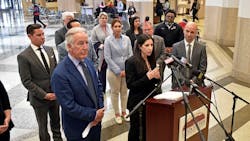SPRINGFIELD — East-west passenger rail connecting all of western and central Massachusetts to Boston — without the traffic-clogged MassPike — is the region’s number one economic development priority.
That’s what U.S. Rep. Richard E. Neal, D- Springfield, said, after an hour-and-a-half-long meeting between local lawmakers and state transportation officials tasked with making the project happen, including track improvements and a park-and-ride station in Palmer.
“We are on fire to get this moving,” said Neal. “It is underway.”
Monday was also a chance for Massachusetts Department of Transportation West-East Rail Director Andy Koziol and MassDOT Rail and Transit Administrator Meredith Slesinger to visit with lawmakers at Springfield Union Station, the center of the state’s east-west-north-south Compass Rail long-term plan.
The meeting also included representatives from the Economic Development Council of Western Massachusetts, the Springfield Regional Chamber and Mayor Domenic J. Sarno.
Neal, dean of New England’s congressional delegation and the ranking Democrat — and past chairman — of the powerful House Ways and Means Committee, said he suggested a series of monthly or bimonthly follow-up meetings in the Statehouse with Lt. Gov. Kim Driscoll. That way, the momentum stays strong.
Design work on $135 million in rail improvements between Springfield and Worcester happens this summer, with construction in 2027 and two new trains a day from New Haven, Connecticut, through Springfield to Boston starting two years after that in 2029. The work is funded in part with a $108 million federal Consolidated Rail Infrastructure and Safety Improvements, or CRISI, grant.
Also, the Healey-Driscoll administration included $12 million in the state’s capital plan to study locations for a Palmer rail station and to improve Pittsfield’s passenger station.
“It’s another huge step in the right direction, a reminder that Joe Biden’s infrastructure bill ... is already coming to allocation,” Neal said. “... The money is now moved a bit beyond the planning stage and a bit toward implementation.”
Full implementation is expected by 2045.
“This is a big deal,” Neal said. “I think you have to think big in this business, because rail is becoming, once again, very popular across the country.”
State Sen. Jake Oliveira, D- Ludlow, acknowledged that it will take years to bring the project to fruition. But he said to keep perspective.
“If we can speed this up and get this expedited, I think there can be some ability to, hopefully, shorten that timeline. Massachusetts is actually moving faster than other states right now,” Oliveira said. “We are the first application (from) any other state for some of the rail dollars.”
“We have a bipartisan group of legislators committed to his project,” he said.
An advisory group also is working to pick the best site for a Palmer station, one that would serve passengers from Springfield’s eastern suburbs, Amherst and towns into Connecticut.
“Palmer’s growth and Palmer’s future is tied to rail,” Oliveira said.
Lawmakers acknowledged that those initial trains would come up from New Haven, but emphasized the need to link the passenger rail system to points west of here, said state Rep. Tricia Farley-Bouvier, D- Pittsfield.
“Western Mass. (must) to hang together in order to get the investments in Western Mass.,” Farley-Bouvier said. ”For us, Springfield west is incredibly important. Not just to Pittsfield but on to Albany.”
Koziol, who came on board in February, said additional passenger rail means people are connected to workplaces, and businesses are connected to employees.
“Typically we will see residential development,” Koziol said. “So we expect that any sort of transportation investment will be followed by development in both housing and business.”
South Station in Boston needs to be expanded for east-west rail to really work, Slesinger noted. But any expansion there means taking back space from the U.S. Post Office in downtown Boston. Initial expansion of service into Boston — those first two trains a day — can be done without expanding South Station.
Observers fear that an expensive Boston project, like South Station, could muscle out Western Massachusetts’ projects for funding dollars.
MassDOT recently announced sold ridership numbers for north-south service through Springfield. Ridership on the Valley Flyer through Holyoke, Northampton and Greenfield was 52% higher in February than last year and 57% higher than pre-pandemic levels.
“We have rebounded from COVID more successfully than we could have imagined,” Slesinger said.
She said success of those trains — as well as the success of the Berkshire Flyer seasonal service from New York to Pittsfield — is a case study in the unmet demand for more rail service generally.
©2024 Advance Local Media LLC. Visit masslive.com. Distributed by Tribune Content Agency, LLC.



